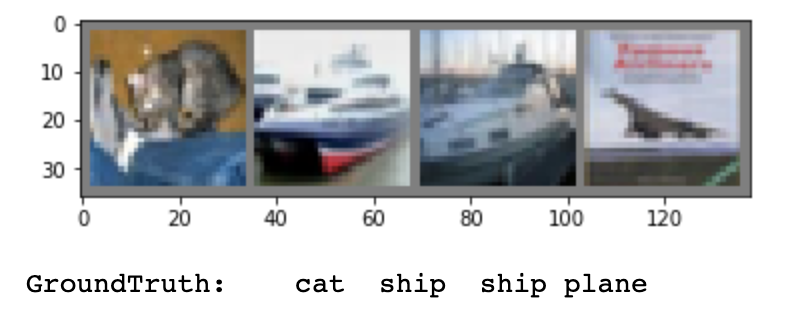Solving CIFAR-10 with Pytorch and SKL
Marton Trencseni - Tue 14 May 2019 - Machine Learning
Introduction
CIFAR-10 is a classic image recognition problem, consisting of 60,000 32x32 pixel RGB images (50,000 for training and 10,000 for testing) in 10 categories: plane, car, bird, cat, deer, dog, frog, horse, ship, truck. Convolutional Neural Networks (CNN) do really well on CIFAR-10, achieving 99%+ accuracy. The Pytorch distribution includes an example CNN for solving CIFAR-10, at 45% accuracy. I will use that and merge it with a Tensorflow example implementation to achieve 75%. We use torchvision to avoid downloading and data wrangling the datasets. Like in the previous MNIST post, I use SciKit-Learn to calculate goodness metrics and plots. You can run this on your laptop in a couple of hours without a GPU, the ipython notebook is up on Github.

The neural network
The CNN architecture is from this example implementation, ported to Pytorch, with log_softmax() at the final layer like in the MNIST CNN:
class CNN(nn.Module):
def __init__(self):
super(CNN, self).__init__()
self.conv1 = nn.Conv2d(3, 64, 3)
self.conv2 = nn.Conv2d(64, 128, 3)
self.conv3 = nn.Conv2d(128, 256, 3)
self.pool = nn.MaxPool2d(2, 2)
self.fc1 = nn.Linear(64 * 4 * 4, 128)
self.fc2 = nn.Linear(128, 256)
self.fc3 = nn.Linear(256, 10)
def forward(self, x):
x = self.pool(F.relu(self.conv1(x)))
x = self.pool(F.relu(self.conv2(x)))
x = self.pool(F.relu(self.conv3(x)))
x = x.view(-1, 64 * 4 * 4)
x = F.relu(self.fc1(x))
x = F.relu(self.fc2(x))
x = self.fc3(x)
return F.log_softmax(x, dim=1)
This time, let's automate printing out how many parameters the net has:
total = 0
print('Trainable parameters:')
for name, param in model.named_parameters():
if param.requires_grad:
print(name, '\t', param.numel())
total += param.numel()
print()
print('Total', '\t', total)
Output (formatted):
Trainable parameters:
conv1.weight 1,728
conv1.bias 64
conv2.weight 73,728
conv2.bias 128
conv3.weight 294,912
conv3.bias 256
fc1.weight 131,072
fc1.bias 128
fc2.weight 32,768
fc2.bias 256
fc3.weight 2,560
fc3.bias 10
-----------------------
Total 537,610
Getting data
As mentioned, we use torchvision here:
transform = transforms.Compose([
transforms.ToTensor(),
transforms.Normalize((0.5, 0.5, 0.5), (0.5, 0.5, 0.5))
])
train_loader = torch.utils.data.DataLoader(
torchvision.datasets.CIFAR10(
root='./data',
train=True,
download=True,
transform=transform),
batch_size=4,
shuffle=True,
num_workers=2)
test_loader = torch.utils.data.DataLoader(
torchvision.datasets.CIFAR10(
root='./data',
train=False,
download=True,
transform=transform),
batch_size=4,
shuffle=False,
num_workers=2)
The only trick here is the normalization. The mean and standard deviation passed in is the actual value computed for the dataset, after normalization (subtract and divide) the dataset will be a standard normal N(0,1) distribution. This just helps the training.
Training the model
Training is straightforward. I've modified the code so it returns the losses, so we can plot it later:
def train(model, device, train_loader, optimizer, epoch):
losses = []
model.train()
for batch_idx, (data, target) in enumerate(train_loader):
data, target = data.to(device), target.to(device)
optimizer.zero_grad()
output = model(data)
loss = F.nll_loss(output, target)
loss.backward()
optimizer.step()
losses.append(loss.item())
if batch_idx > 0 and batch_idx % 1000 == 0:
print('Train Epoch: {} [{}/{}\t({:.0f}%)]\tLoss: {:.6f}'.format(
epoch, batch_idx * len(data), len(train_loader.dataset),
100. * batch_idx / len(train_loader), loss.item()))
return losses
This is a plain vanilla training loop, with nll_loss(). This stands for negative log likelihood (NLL).
NLL essentially transforms the class probability (0 to 1) to run from ∞ to 0, good for a loss function. The combination of outputing log_softmax() and minimizing nll_loss() is mathematically the same as outputing the probabilities and minimizing cross-entropy (how different are two probability distributions, in bits), but with better numerical stability.
Using matplotlib we can see how the model converges:
def mean(li): return sum(li)/len(li)
plt.figure(figsize=(14, 4))
plt.xlabel('training batch')
plt.ylabel('loss')
plt.plot([mean(losses[i:i+1000]) for i in range(len(losses))])

By computing the accuracy on the training set at the end of each epoch, we can see how our model improves:

Evaluating the model
Now we use the test data portion of CIFAR-10, and run the model on it. Most SKL metrics expect 2 of 3 inputs:
- the ground truth labels
- the predicted labels
- the prediction probabilities (for eg. ROC curve)
Now we can use SKL to get various metrics:
def test_label_predictions(model, device, test_loader):
model.eval()
actuals = []
predictions = []
with torch.no_grad():
for data, target in test_loader:
data, target = data.to(device), target.to(device)
output = model(data)
prediction = output.argmax(dim=1, keepdim=True)
actuals.extend(target.view_as(prediction))
predictions.extend(prediction)
return [i.item() for i in actuals], [i.item() for i in predictions]
actuals, predictions = test_label_predictions(model, device, test_loader)
print('Confusion matrix:')
print(confusion_matrix(actuals, predictions))
print('F1 score: %f' % f1_score(actuals, predictions, average='micro'))
print('Accuracy score: %f' % accuracy_score(actuals, predictions))
Outputs:
Confusion matrix:
[[778 20 37 12 18 6 2 25 65 37]
[ 6 854 7 5 2 4 1 1 44 76]
[ 61 5 525 97 89 92 55 36 24 16]
[ 20 10 32 587 65 162 45 35 19 25]
[ 9 5 34 63 715 51 41 65 13 4]
[ 13 4 28 155 41 683 12 44 9 11]
[ 7 2 24 62 25 37 814 5 13 11]
[ 13 3 17 38 54 61 10 785 5 14]
[ 39 9 12 14 4 1 5 6 874 36]
[ 23 56 6 14 4 4 5 14 35 839]]
F1 score: 0.745400
Accuracy score: 0.745400
Let's see the ROC curve for the cat(3) class:
def test_class_probabilities(model, device, test_loader, which_class):
model.eval()
actuals = []
probabilities = []
with torch.no_grad():
for data, target in test_loader:
data, target = data.to(device), target.to(device)
output = model(data)
prediction = output.argmax(dim=1, keepdim=True)
actuals.extend(target.view_as(prediction) == which_class)
probabilities.extend(np.exp(output[:, which_class]))
return [i.item() for i in actuals], [i.item() for i in probabilities]
which_class = 3
actuals, class_probabilities = test_class_probabilities(model, device, test_loader, which_class)
fpr, tpr, _ = roc_curve(actuals, class_probabilities)
roc_auc = auc(fpr, tpr)
plt.figure()
lw = 2
plt.plot(fpr, tpr, color='darkorange',
lw=lw, label='ROC curve (area = %0.2f)' % roc_auc)
plt.plot([0, 1], [0, 1], color='navy', lw=lw, linestyle='--')
plt.xlim([0.0, 1.0])
plt.ylim([0.0, 1.05])
plt.xlabel('False Positive Rate')
plt.ylabel('True Positive Rate')
plt.title('ROC for label=cat(%d) class' % which_class)
plt.legend(loc="lower right")
plt.show()

Conclusion
While this result is not state-of-the-art, it's still much better than random, which would be 10% accuracy. I was able to run this with minimal changes from the MNIST code, since the model and the train/test framework are cleanly separated.